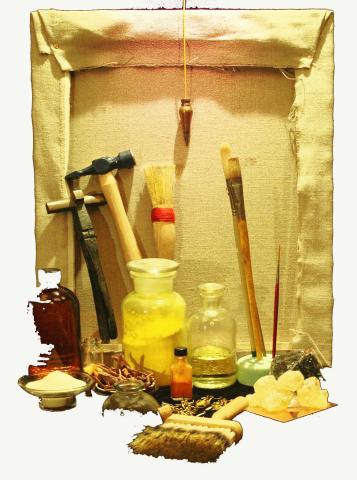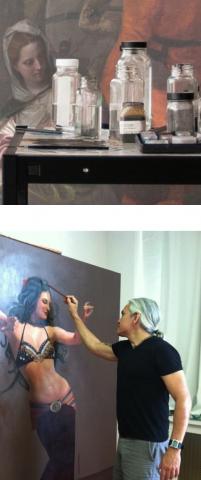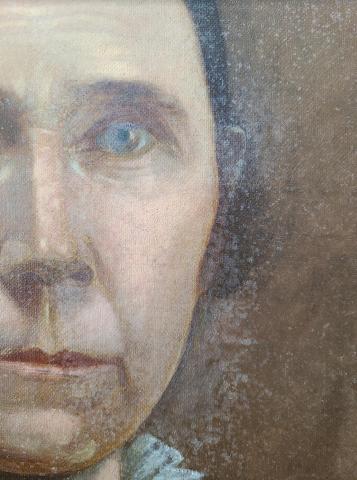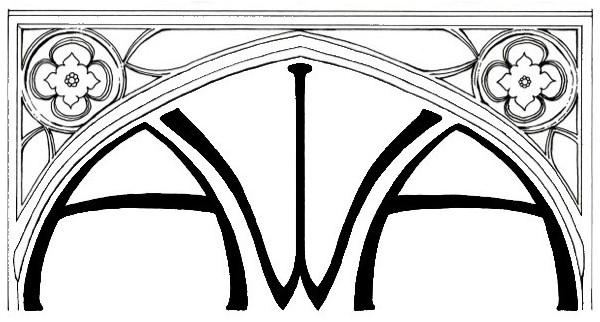Oil and Acrylic Painting Restoration
 Oil painting restoration involves the cleaning, repair, and preservation of an oil painting in order to restore it to its original condition or improve its appearance. The process typically involves a combination of technical analysis, cleaning, structural stabilization, and retouching. The first step in the restoration process is to evaluate the painting to determine its condition and identify any areas of damage or deterioration. This involves a careful examination of the surface of the painting, as well as an analysis of the materials and techniques used by the artist. The next step is to clean the painting, which may involve the use of specialized solvents, detergents, and other cleaning agents to remove dirt, grime, and other contaminants that have accumulated on the surface of the painting over time. This is a delicate and meticulous process that requires the use of specialized tools and techniques.
Oil painting restoration involves the cleaning, repair, and preservation of an oil painting in order to restore it to its original condition or improve its appearance. The process typically involves a combination of technical analysis, cleaning, structural stabilization, and retouching. The first step in the restoration process is to evaluate the painting to determine its condition and identify any areas of damage or deterioration. This involves a careful examination of the surface of the painting, as well as an analysis of the materials and techniques used by the artist. The next step is to clean the painting, which may involve the use of specialized solvents, detergents, and other cleaning agents to remove dirt, grime, and other contaminants that have accumulated on the surface of the painting over time. This is a delicate and meticulous process that requires the use of specialized tools and techniques.
 Once the painting has been cleaned, any areas of damage or deterioration may be addressed through structural stabilization or retouching. Structural stabilization involves reinforcing the canvas or other support structure of the painting to prevent further damage or deterioration, while retouching involves filling in areas of missing paint or repairing areas where the paint has become cracked, flaked off, or faded. Lastly, the painting may be varnished or sealed to protect it from further damage and preserve its appearance. This may involve the application of a clear protective coating or varnish over the surface of the painting, which can help to protect it from environmental factors such as light, humidity, dust, and temperature changes.
Once the painting has been cleaned, any areas of damage or deterioration may be addressed through structural stabilization or retouching. Structural stabilization involves reinforcing the canvas or other support structure of the painting to prevent further damage or deterioration, while retouching involves filling in areas of missing paint or repairing areas where the paint has become cracked, flaked off, or faded. Lastly, the painting may be varnished or sealed to protect it from further damage and preserve its appearance. This may involve the application of a clear protective coating or varnish over the surface of the painting, which can help to protect it from environmental factors such as light, humidity, dust, and temperature changes.
 The Craft of Fine Art Restoration
The Craft of Fine Art Restoration
The treatments executed in our studio are in compliance with the American Institute for Conservation Code of Ethics and Guidelines for Practice. When conserving a piece, our goal is to preserve the artist’s original intent by using non-invasive and reversible techniques and utilizing archival-grade materials. Only specific areas on the painting are retouched. Restoring oil paintings required a thorough understanding of the process of making and painting one, as there are times that severe damages may require more than retouching.
 Vicente Saavedra has been creating oil paintings for more than 20 years as an artist and educator. Traditional portraiture and figurative art have been his areas of expertise. On many occasions he stretched and sized linens and canvases using traditional sizing materials. The primer used depended on the medium, the style of the work, and the type of paint. Some traditional primers are made with lead white, marble dust, glass dust, and oils. Lead-based paints were a favorite in the 19th century for their brilliance and binding qualities, and they are still a favorite among contemporary portrait and classical painters today. Lead-based mediums such as black oil and Maroger, are substances only traditional painters know about and understand. They were often used during the nineteenth century for their versatility, handling, and brilliance.
Vicente Saavedra has been creating oil paintings for more than 20 years as an artist and educator. Traditional portraiture and figurative art have been his areas of expertise. On many occasions he stretched and sized linens and canvases using traditional sizing materials. The primer used depended on the medium, the style of the work, and the type of paint. Some traditional primers are made with lead white, marble dust, glass dust, and oils. Lead-based paints were a favorite in the 19th century for their brilliance and binding qualities, and they are still a favorite among contemporary portrait and classical painters today. Lead-based mediums such as black oil and Maroger, are substances only traditional painters know about and understand. They were often used during the nineteenth century for their versatility, handling, and brilliance.
Traditional oil paintings such as portraits and figurative work are usually created with “velaturas” or layers of paint to produce likeness or a desired realistic effect. Varnish is used as a topcoat for oil paintings to bring all the layers of paint together as well as to protect them. Sometimes varnish may have been applied on top of a dirty painting as a way to “freshen up the work”. But without proper cleaning, such paintings may have dirt trapped between the varnish layers.
 Oil varnish tends to darken with time, turning into a yellowish-brown layer that clouds over the real colors of the painting. Cloudy or dull spots can develop over the varnish due to moisture in the air. In cases like these it is recommended to clean the painting and replace the varnish for one that never turns yellow and that is easy to remove in the future.
Oil varnish tends to darken with time, turning into a yellowish-brown layer that clouds over the real colors of the painting. Cloudy or dull spots can develop over the varnish due to moisture in the air. In cases like these it is recommended to clean the painting and replace the varnish for one that never turns yellow and that is easy to remove in the future.
Synthetic painting varnishes and resins are man-made materials that have been developed as alternatives to traditional varnish resins, which are derived from natural sources. These synthetic materials have several advantages, including greater durability, clarity, and resistance to yellowing and environmental factors.
 Restoring a painting may include the following treatments:
Restoring a painting may include the following treatments:
-The removal of surface dirt, such as dust, soot, and smoke
-The removal and replacement of aged, yellowed, or discolored varnish
-The replacement of missing sections of paint
-The repair of painting damage, such as tears and holes in the canvas
-The restoration of the frame or moldings of the frame
To receive a free estimate, please call or write to set up an appointment to examine the painting.
Contact Us
 Oil painting restoration involves the cleaning, repair, and preservation of an oil painting in order to restore it to its original condition or improve its appearance. The process typically involves a combination of technical analysis, cleaning, structural stabilization, and retouching. The first step in the restoration process is to evaluate the painting to determine its condition and identify any areas of damage or deterioration. This involves a careful examination of the surface of the painting, as well as an analysis of the materials and techniques used by the artist. The next step is to clean the painting, which may involve the use of specialized solvents, detergents, and other cleaning agents to remove dirt, grime, and other contaminants that have accumulated on the surface of the painting over time. This is a delicate and meticulous process that requires the use of specialized tools and techniques.
Oil painting restoration involves the cleaning, repair, and preservation of an oil painting in order to restore it to its original condition or improve its appearance. The process typically involves a combination of technical analysis, cleaning, structural stabilization, and retouching. The first step in the restoration process is to evaluate the painting to determine its condition and identify any areas of damage or deterioration. This involves a careful examination of the surface of the painting, as well as an analysis of the materials and techniques used by the artist. The next step is to clean the painting, which may involve the use of specialized solvents, detergents, and other cleaning agents to remove dirt, grime, and other contaminants that have accumulated on the surface of the painting over time. This is a delicate and meticulous process that requires the use of specialized tools and techniques.
 Once the painting has been cleaned, any areas of damage or deterioration may be addressed through structural stabilization or retouching. Structural stabilization involves reinforcing the canvas or other support structure of the painting to prevent further damage or deterioration, while retouching involves filling in areas of missing paint or repairing areas where the paint has become cracked, flaked off, or faded. Lastly, the painting may be varnished or sealed to protect it from further damage and preserve its appearance. This may involve the application of a clear protective coating or varnish over the surface of the painting, which can help to protect it from environmental factors such as light, humidity, dust, and temperature changes.
Once the painting has been cleaned, any areas of damage or deterioration may be addressed through structural stabilization or retouching. Structural stabilization involves reinforcing the canvas or other support structure of the painting to prevent further damage or deterioration, while retouching involves filling in areas of missing paint or repairing areas where the paint has become cracked, flaked off, or faded. Lastly, the painting may be varnished or sealed to protect it from further damage and preserve its appearance. This may involve the application of a clear protective coating or varnish over the surface of the painting, which can help to protect it from environmental factors such as light, humidity, dust, and temperature changes.
 The Craft of Fine Art Restoration
The Craft of Fine Art RestorationThe treatments executed in our studio are in compliance with the American Institute for Conservation Code of Ethics and Guidelines for Practice. When conserving a piece, our goal is to preserve the artist’s original intent by using non-invasive and reversible techniques and utilizing archival-grade materials. Only specific areas on the painting are retouched. Restoring oil paintings required a thorough understanding of the process of making and painting one, as there are times that severe damages may require more than retouching.
 Vicente Saavedra has been creating oil paintings for more than 20 years as an artist and educator. Traditional portraiture and figurative art have been his areas of expertise. On many occasions he stretched and sized linens and canvases using traditional sizing materials. The primer used depended on the medium, the style of the work, and the type of paint. Some traditional primers are made with lead white, marble dust, glass dust, and oils. Lead-based paints were a favorite in the 19th century for their brilliance and binding qualities, and they are still a favorite among contemporary portrait and classical painters today. Lead-based mediums such as black oil and Maroger, are substances only traditional painters know about and understand. They were often used during the nineteenth century for their versatility, handling, and brilliance.
Vicente Saavedra has been creating oil paintings for more than 20 years as an artist and educator. Traditional portraiture and figurative art have been his areas of expertise. On many occasions he stretched and sized linens and canvases using traditional sizing materials. The primer used depended on the medium, the style of the work, and the type of paint. Some traditional primers are made with lead white, marble dust, glass dust, and oils. Lead-based paints were a favorite in the 19th century for their brilliance and binding qualities, and they are still a favorite among contemporary portrait and classical painters today. Lead-based mediums such as black oil and Maroger, are substances only traditional painters know about and understand. They were often used during the nineteenth century for their versatility, handling, and brilliance. Traditional oil paintings such as portraits and figurative work are usually created with “velaturas” or layers of paint to produce likeness or a desired realistic effect. Varnish is used as a topcoat for oil paintings to bring all the layers of paint together as well as to protect them. Sometimes varnish may have been applied on top of a dirty painting as a way to “freshen up the work”. But without proper cleaning, such paintings may have dirt trapped between the varnish layers.
 Oil varnish tends to darken with time, turning into a yellowish-brown layer that clouds over the real colors of the painting. Cloudy or dull spots can develop over the varnish due to moisture in the air. In cases like these it is recommended to clean the painting and replace the varnish for one that never turns yellow and that is easy to remove in the future.
Oil varnish tends to darken with time, turning into a yellowish-brown layer that clouds over the real colors of the painting. Cloudy or dull spots can develop over the varnish due to moisture in the air. In cases like these it is recommended to clean the painting and replace the varnish for one that never turns yellow and that is easy to remove in the future.Synthetic painting varnishes and resins are man-made materials that have been developed as alternatives to traditional varnish resins, which are derived from natural sources. These synthetic materials have several advantages, including greater durability, clarity, and resistance to yellowing and environmental factors.
 Restoring a painting may include the following treatments:
Restoring a painting may include the following treatments:-The removal of surface dirt, such as dust, soot, and smoke
-The removal and replacement of aged, yellowed, or discolored varnish
-The replacement of missing sections of paint
-The repair of painting damage, such as tears and holes in the canvas
-The restoration of the frame or moldings of the frame
Contact Us
